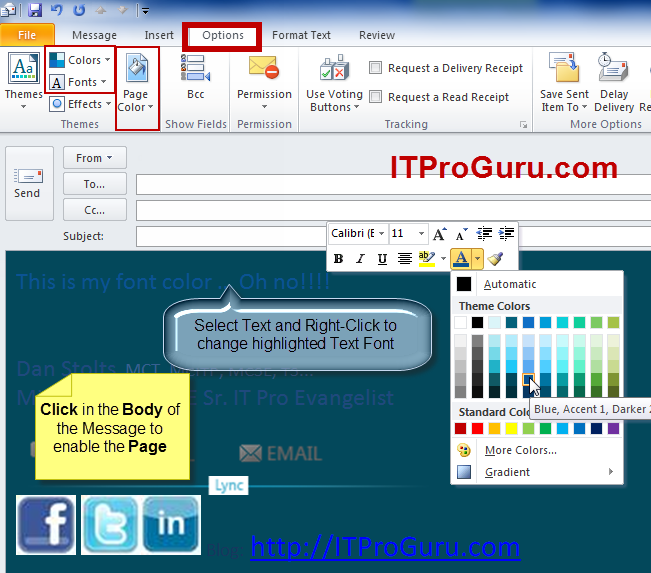

- #Change selected cell background color word 2013 how to#
- #Change selected cell background color word 2013 code#

On the home tab, in the Styles subgroup, click on Conditional Formatting→New Rule. Now suppose if we want to change cell E3 color to blue if the D3 value is greater than 3 and to green if the D3 value is greater than 5 and to red, if D3’s value is greater than 10, we can do that with the conditional format using a formula.įirst, select the cell on which you want to apply conditional format, here we need to select cell E3. Suppose we want to change the color of cell E3 based on the value in D3, to do that we have to use a formula in conditional formatting.

In the example above, we are changing the cell color based on that cell value only, we can also change the cell color based on other cells value as well. In the example below, we use beginning with “J” and then select Format button to select Blue as the fill color.Ĭonditional format based on another cell value Now select Format only cells that contain the option, then in the first drop down select “ Specific Text” and in the second drop-down select either of the 4 options: containing, not containing, beginning with, ending with. Similarly, we can do the same process for text values as well instead of numerical values by using the “ Specific Text” in the first drop down and in the second drop-down select either of 4 values containing, not containing, beginning with, ending with and then enter the specific text in the text box.įirst, select the cell on which you want to apply conditional format, here we need to select cell B1. Repeat the same process for 11-20 and 21-30 and you’ll see that number changes as per the value of the cell. Now enter a value between 0 and 10 in cell E3 and you will see that cell color changes to blue and if there is any other value or no value then cell color revert to transparent. Then, on the first box, enter 0 and in the second box, enter 10, then click on the Format button and go to Fill Tab, select the blue color, click Ok and again click Ok. Then select “ Format only cells that contain,” then in the first drop down select “ Cell Value” and in the second drop-down select “ between” : Note: Make sure the cell on which you want to apply conditional formatting is selected On the Home tab, in the Style subgroup, click on Conditional Formatting→ New Rule. We can achieve this with the help of Conditional Formatting. Any other value or Blank : No color or No Fill.21-30 : We want the cell color to be Yellow.

11-20 : We want the cell color to be Red.0-10 : We want the cell color to be Blue.
#Change selected cell background color word 2013 code#
Say, we want to color code the cell E3 as follows: Now, what if we want to change the cell color based on cell value? Suppose we want the color of cell E3 to change with the change of the value in it. Conditional formatting cell color based on cell value We can refer to this as static formatting of the cell E3. This means that cell color is independent of cell value, so no matter what value will be in E3 the cell color will always be blue. In the above example, the color of cell E3 has been changed from No Fill to Blue color, and notice that the value in cell E3 is 6 and if we change the value in this cell from 6 to any other value the cell color will not change and it will always remain blue. You can change the color of cells by going into the formatting of the cell and then go into the Fill section and then select the intended color to fill the cell. Fill a cell with color based on a conditionīefore learning to conditionally format cells with color, here is how you can add color to any cell in Excel. If you want to fill a cell with color based on a condition, you will need to use the Conditional Formatting feature. There are several ways to color format cells in Excel, but not all of them accomplish the same thing.
#Change selected cell background color word 2013 how to#
Using CSS and jquery: $(document).Learn How to Fill a Cell with Color Based on a Condition If (colorCode.innerHTML="In Progress")Ĭ='Orange' Ĭ='green' Ĭ='Red' Ĭhange the Color of a Column in a List in SharePoint If (colorCode.innerHTML="Not Started")//finding the word to which the color has to be setĬ='lightblue' // setting the color depending upon the valueĬ='Black' // setting the color of the words inside the contentĬ='Brown' Var colorCode = document.getElementsByTagName("td")// finding all the TD tags Select the column DDL(IsApproved) from the view -> Click on the Column Settings -> Click on the Format this column -> In the right panel click on the switch to design mode ->įrom this UI formatting - we can generate the equivalent JSON code as well. If this is your SharePoint online environment, it can be achieved with just few clicks:


 0 kommentar(er)
0 kommentar(er)
